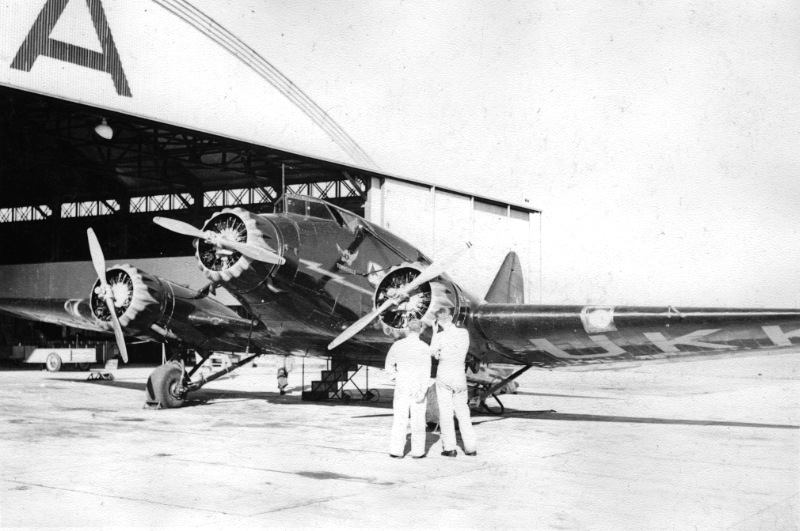
Airlines of Australia Ltd Stinson A VH-UKK "City of Townsville" at Archerfield Aerodrome, Brisbane 1941. Photo by Charles.D.Pratt
Airlines of Australia had been formed the previous year in a restructure of New England Airways Ltd, Lismore NSW. Founder and Managing Director Mr.George A.Robinson of the New England Motor Company at Lismore had attracted British financial backing to enable his planned expansion. With new name Airlines of Australia Ltd, the first new aircraft were small British GAL Monospars, which proved barely adequate. G.A.Robinson had his sights set on new all-metal American airliners. When the Australian Civil Aviation Board finally dropped its ban on US-built aircraft in November 1935, Robinson immediately sailed to the United States in December 1935 on the liner Monterey. Facing lengthy delivery delays for Douglas DC-2 and DC-3s, his aim was to inspect other airline types which could be put into AOA service in the meantime.
Robinson acted quickly. Impressed by the 8 to10 passenger Stinson A trimotors already in American airline use, he ordered three aircraft for early completion to be shipped to Australia, later adding an order for a fourth. The announcement was made in the Australian press on 20 January 1936. AOA's status was boosted by the arrival of the Stinsons later that year combined with route expansion north from Brisbane to Townville via enroute coastal cities. It had become a major competitor to the newly-formed Australian National Airways Pty Ltd, Melbourne.
ANA was formed by mergers of existing companies giving a route network from Sydney south, to Melbourne, Tasmania, Adelaide and Perth, while AOA operated from Sydney north to Brisbane and Townsville. In March 1937 this uncomfortable relationship was partially resolved by ANA buying a controlling financial interest in AOA. The two airlines continued to operate independently: ANA based at Melbourne operated all routes south to Tasmania, west to Perth and the all-important Melbourne-Canberra-Sydney. AOA based at Sydney covered routes north to Brisbane and Townsville, extended north to Cairns and Horn Island from December 1938 when AOA took over North Queensland Airways Pty Ltd, Cairns.
Finally in July 1942 ANA absorbed AOA - Airlines of Australia Ltd was no more.
When the Stinsons arrived AOA publicity emphasised their speed and modern safety features such as retracting undercarriage. But in reality they were the same welded steel tube airframe with wood decking and fabric covering as the old Avro Tens they replaced. But the passenger cabin was much improved with American attention to passenger comfort. All four were delivered in the same paintwork of all over dark blue with red trim.
AOA senior pilot, Captain Keith Virtue later said "The Stinsons were damned good aeroplanes. They had been promised to cruise at 160mph but they cruised comfortably at 165 mph, quite a different story to the disappointing Monospars and DH.86s. With their big donut tyres you could flop a Stinson on the ground and you wouldn't feel it. They had Argon fluorescent lights that you could switch on to brighten up the luminous dials on the instrument panels during night flying. It was most effective and the Douglas DC-2s and DC-3s didn't have it until much later."
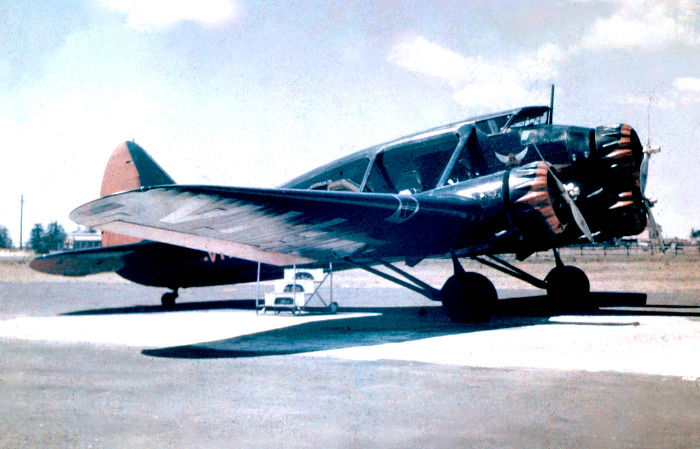
In 1939 Stinson Aircraft became a division of Vultee Aircraft with a common parent company AVCO. In March 1943 it became the Stinson Division of Consolidated-Vultee (Convair) and wartime employment at the Wayne plant reached 2,000. Post-war Stinson continued building the civil Model 108 Voyager but sales slumped and Convair closed the Stinson factory at Wayne MI in June 1947, in December that year selling the Stinson assets, name and goodwill to Piper Aircraft Corporation.
The two remaining Stinsons VH-UYY & VH-UKK had been spared Government impressment for the Royal Australian Air Force. They were classified as essential civilian airliners to allow minimal domestic air services. AOA and ANA lost other airliners to impressment for the RAAF and were desperate to keep the Stinsons in service. When AOA was absorbed into ANA in July 1942 the two Stinsons were maintaining the Queensland coastal routes between Brisbane and Horn Island but faced grounding because of lack of engine parts. ANA's Senior Engineer submitted plans to DCA to re-engine the Stinsons with 335hp Armstrong Siddleey Cheetah IX radials (in plentiful supply for RAAF Avro Ansons) or alternatively much more power with just two Pratt & Whitney 650hp R-1340-S3H1 Wasp geared engines (manufactured under licence in Australia by Commonwealth Aircraft Corporation for their Wirraway production). The final decision was to use two 550hp P&W R-1340-AN1 Wasps, a direct drive model available from military stocks. Suitable 2D40 metal constant-speed propellers were acquired from De Havilland Aircraft Pty Ltd, Sydney. DCA's Aeronautical Engineering Branch in Melbourne undertook stress analysis calculations and structural redesign and strengthening required to carry the extra engine weight and power.The missing centre engine was replaced by a rounded light gauge aluminium sheet structure nose.
37
Sqn ORB: 2.8.43 A61-1 Northrop Delta arrived at 37 Sqn Laverton. This
was the unit's first aircraft prior to Lodestars (unit formed at
Laverron 15.7.43: first Lodestar A67-5 arrived Laverton 28.8.43)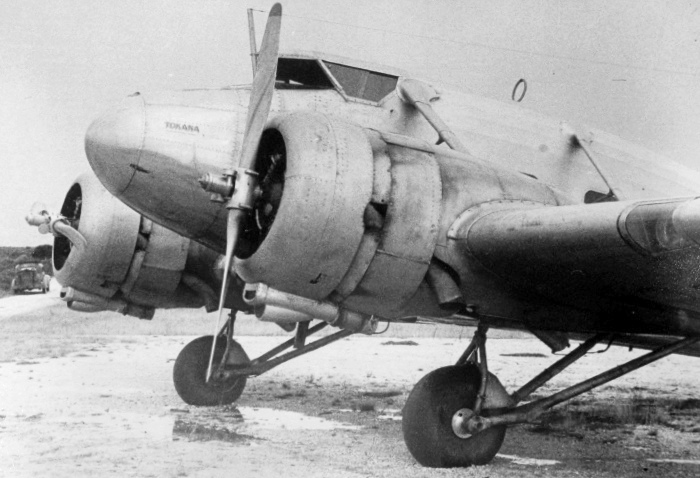

Ugly
duckling. The Stinson A2W conversions to two P&W Wasps was a
wartime
necessity. Photo by Charles D.Pratt
However the entire conversion process came under intense scrutiny in January 1945 when VH-UYY broke up in flight only 14 months after its re-engining. The DCA accident investigation found that the primary structural failure was the port wing spar caused by a fatigue crack, resulting in the port wing detaching from the airframe. Press reports of passengers on earlier flights in VH-UYY hearing cracking noises in flight and seeing cracks in the elevator attachments caused such adverse publicity that the Minister for Civil Aviation (Mr.Arthur Drakeford) established an Air Court of Enquiry to review every aspect of the accident. Among its findings was that the sensational reporting of passenger comments had no basis in fact. The sole cause was the port wingspar fatigue crack which started within a weld, undectable to the eye and had been slowly extending for some years. The re-engining to P&W Wasps did not directly contribute to the existing crack progressing, other than extend the flying life of the airframe. The aircraft's high utilisation usually at full loads, particularly on the Melbourne-Mildura-Broken Hill route noted for turbulent flying conditions, probably accelerated the progress of the crack.
These were among the earliest investigations of metal fatigue causing an in-flight structural failure. As a result of their findings, DCA changed the way metal airframe structures were examined during overhauls, now requiring Magnaflux inspections. The Department also began the practice of calculating the safe retirement life of metal aircraft registered in Australia. Increased funding was provided for technical testing for airframe metal fatigue. in Melbourne the Structures and Materials Division of the Division of Aeronautics (later Aeronautical Research Laboratories) commenced a long-term program aimed at advancing the knowledge of metal fatigue in aircraft structures. Some 200 surplus wings of P-51 Mustang were tested by repeated loading to examine the characteristics of fatigue. In Sydney the CSIR (Council for Scientific and Industrial Research, predecessor of CSIRO) was issued with war disposals RAAF Douglas DC-2s for similar tests.
The Departmental files for the Stinson As contain numerous detailed reports of forced landings and en-route diversions, usually due to weather or engine troubles. Such reports were madatory for airline category aircraft at the time. I have only included events in which the aircraft was damaged.
| 28.1.36 |
Built at Wayne, Michigan by Stinson Aircraft Corporation at their plant adjoining Detroit Metropolitan Airport. Three 245hp Lycoming R-680 radials |
| Originally built to American Airlines order, the final aircraft of 15. Before completion, by agreement between American Airlines and Stinson, it was transferred to Airlines of Australia to enable the early delivery of the first of the Australian order. |
|
| 1.36 |
Registered NC15162 American Airlines. (Not delivered) |
| 2.36 |
Test flown Wayne MI as NC15162 |
| 2.36 |
NC15162 registration cancelled. It was transferred to newly-built Stinson A c/n 9127 to complete the American Airlines' order |
| 2.36 |
Shipped to Sydney as cargo on board SS City of Winchester. |
| Assembly and test flights Sydney were supervised by Stinson Aircraft Corp senior test pilot and engineer Captain H.D.Boyer, who arrived Sydney on SS Makura on 7 March 1936 |
|
| 27.3.36 |
The first Stinson arrived Sydney wharves. Moved by road to Mascot Aerodrome where assembled in the AoA hangar |
| 7.4.36 |
First test flights at Mascot by Captain H.D.Boyer with AOA Chief Pilot Captain Keith Virtue |
| Civil Aviation Board (predecessor of the Department of Civil Aviation) gave approval for the aircraft to be flown pending formal certification. | |
| 14.4.36 |
Flew Sydney-Brisbane in 2hr 45 mins by Captains Virtue & Boyer, engineer W.H.Shiers, with G.A.Robinson as passenger. Previous fastest AOA Avro 10 time was 3 hr 17 mins. Much press publicity, |
| 15.4.36 |
Captains Virtue and Boyer departed Brisbane on
a trial flight to Townsville, with refuelling stop at Rockhampton. Continued
to Cairns next day. On 17 April stopped at Mackay on the soutbound flight. Large crowds gathered at each stop to see the new airliner which was to be used on AOA's Brisbane-Townsville route, serving coastal cities. |
| 16.4.36 |
Registered VH-UGG Airlines of Australia Ltd, Sydney NSW. Named Lismore |
| 16.4.36 |
Australian CofA issued. Passenger seating for 8 to 10. |
| 19.4.36 |
Arrived
Essendon Aerodrome, Melbourne on a demonstration tour from Brisbane and
Sydney, flown by Captain Keith Virtue. At Essendon eight short flights were made carrying invited officials and guests. (Compiler's comment: promoting his advanced Stinson at Holyman's Airways home base Melbourne was gamesmanship by G.A.Robinson as part of his rivalry with Ivan Holyman to see whose airline would emerge as an Australia-wide airline. Holyman went on to create the larger ANA and win.) |
| 24.4.36 |
Commenced
scheduled AOA passenger services Sydney-Lismore-Brisbane, inaugural
passenger service that day flown by Captain Keith Virtue with First
Officer Jason Hassard |
| 5.7.36 |
Tailwheel damaged Ingham Qld when it struck a cow on takeoff, Captain Keith Virtue. |
| 28.3.37 |
Crashed destroyed after takeoff Archerfield Aerodrome, Brisbane Qld. Took off at dawn in thick fog on scheduled AOA service to Townsville. Turned to the right after airborne, struck trees on the airfield boundary, crashed and burned. AOA Captain T.S.Cameron (no copilot) and his one passenger, who was occupying the right hand seat in the cockpit, were killed |
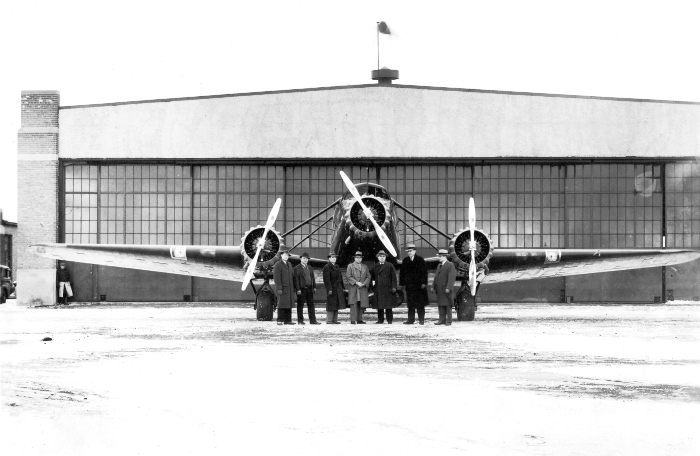
G.A.Robinson and party pose with Stinson officials with AOA's first Stinson A NC15162 at the Detroit factory January 1936.
Photo: Bruce Robinson collection
Photo: Bruce Robinson collection
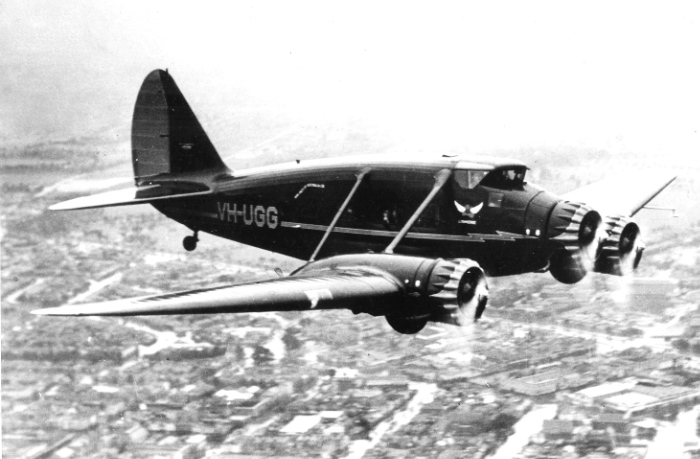
Photo: Civil Aviation Historical Society/Macarthur Job Collection
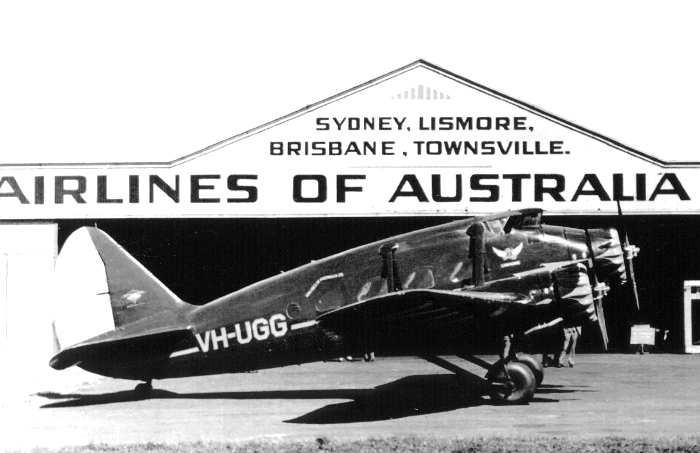
Outside
the AOA hangar at Sydney Airport (Mascot), dark blue with red
trim. Ed Coates Collection
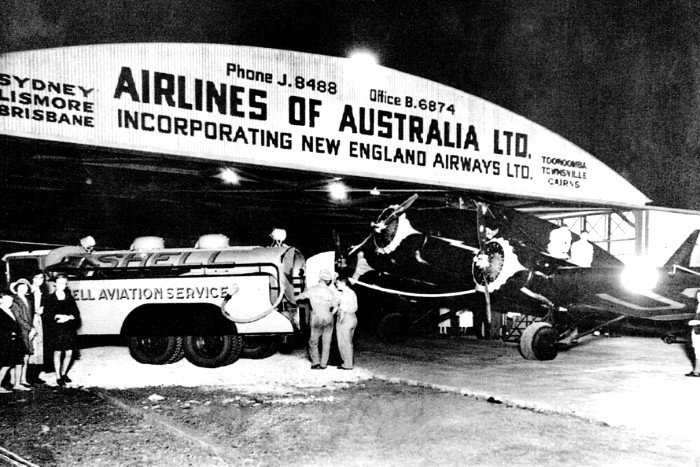
Night
refuelling VH-UGG at Archerfield Aerodrome,
Brisbane.
Bruce Robinson collection

| 27.4.36 |
Built at Wayne, Michigan by Stinson Aircraft Corporation at their plant adjoining Detroit Metropolitan Airport. Three 245hp Lycoming R-680 radials |
| Shipped to Sydney as cargo on board SS Wichita | |
| 22.6.36 |
Arrived Sydney wharves, moved to Mascot aerodrome for assembly by AOA |
| 27.6.36 |
Registered VH-UHH Airlines of Australia Ltd, Sydney NSW |
| 27.6.36 |
Test flight Mascot after assembly |
| 27.6.36 |
Australian CofA issued |
| 19.2.37 |
Crashed in mountains Lamington National Park Qld. Posted missing without trace Departed Archerfield for Lismore and Sydney in poor weather but did not arrive Lismore. The aircraft did not have radio. A large aerial search was called off after 5 days |
| 29.2.37 |
Wreck located. Found by Bernard O'Reilly from the O'Reilly Guest House in the Lamington National Park who was conducting his own overland search on foot. He became a national hero for his efforts in locating the aircraft wreck and assisting the survivors. |
| Captain
Rex Boydon, copilot Beverley Shepherd and two passengers killed on
impact. The other four injured passengers stayed with the wreck. 2 died
and Bernard O'Reilly rescued the remaining two survivors. |
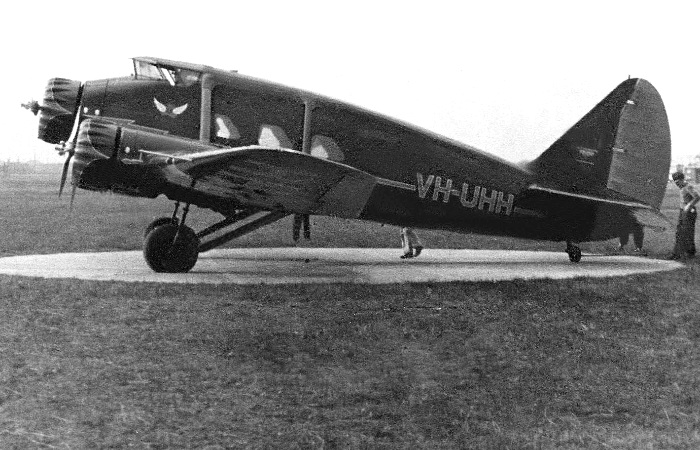
VH-UHH having its compass aligned on the Mascot compass swing bay. Given its short flying career, this photograph
was probably taken at the time of its original assembly. Photo: AOA via Bruce Robinson collection
was probably taken at the time of its original assembly. Photo: AOA via Bruce Robinson collection
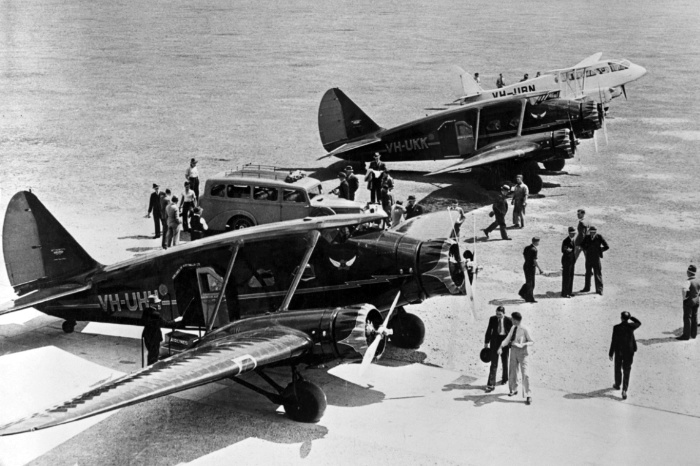
Airlines of Australia Ltd Stinson As and DH.89 Rapide VH-UBN at Archerfield. Macarthur Job Collection CAHS
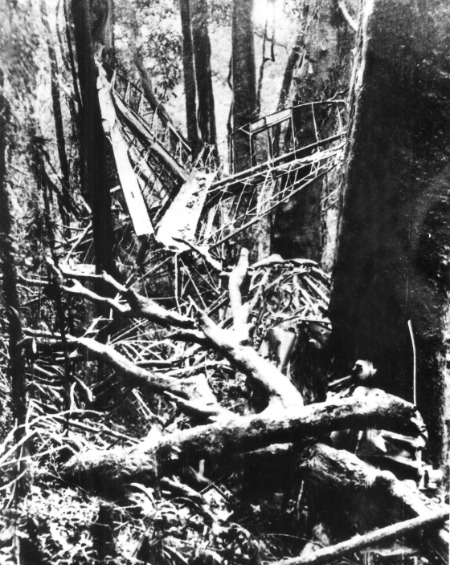
Photo: Macarthur Job Collection, Civil Aviation Historical Society
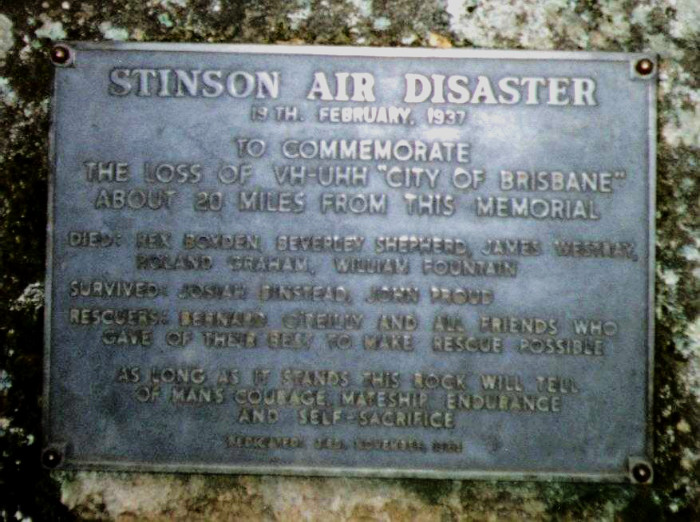
Photo by Bert van Drunick
| 19.5.36 |
Built at Wayne, Michigan by Stinson Aircraft Corporation at their plant adjoining Detroit Metropolitan Airport. Three 245hp Lycoming R-680 radials |
| 6.36 |
Shipped to Sydney as cargo on board SS City of Manila |
| 22.7.36 |
Arrived Sydney wharves. Moved by road to Mascot Aerodrome where assembled in the AoA hangar |
| 30.7.36 |
Registered VH-UKK Airlines of Australia Ltd, Sydney NSW. Named Townsville |
| 30.7.36 |
Australian CofA issued after test flights at Mascot |
| 1.7.42 |
Transferred on merger: Australian National Airways Pty Ltd, Melbourme Vic. Renamed Binana in ANA's aircraft naming convention for words ending in "...ana" |
| 1.43 |
Due lack of Lycoming engine spare parts, VH-UKK & VH-UYY were replaced on the Queensland coastal routes and sent to Essendon Aerodrome, Melbourne for re-engining. |
| 5.43 |
Completed rebuild by ANA at Essendon with two 550hp P&W R-1340-AN1 Wasp radials |
| 29.5.43 |
CofA renewed as Stinson A-2W following test flights at Essendon |
| 5.8.43 |
Port
wing damaged by fire at Mackay Qld. During refuelling, fuel spilt on
the fabric covering of the wing was ignited by a back-fire on engine
start. |
| 8.43 |
In
order to return VH-UKK to service as quickly as possible, the port
outer wing of VH-UYY, then under rebuild at Essendon to twin P&W
Wasps, was sent to Mackay strapped under the fuselage of an ANA
DC-3. It was fitted to VH-UKK while the damaged wing was sent to
ANA Essendon for repair and installation in VH-UYY. The enquiries into
VH-UYY's subsequent crash considered the outer wing swap did not
contribute to the port wing structural failure. |
| 23.12.43 |
Log book ANA First Officer Charles D. Pratt: VH-UKK "Islands Run" Essendon-King Island- Smithton- Launceston-Flinders Island-Launceston-Smithton-King Island-Essendon. Captain Condell |
| 44 |
Based Melbourne, mostly used on services to Broken Hill and Tasmania, with VH-UYY |
| 3.6.44 |
Log book ANA Captain Charles D. Pratt: VH-UKK Essendon-Kerang-Mildura-Broken Hill return. First Officer E. Child. Pratt's diary gives more detail: "Due out on UYY at 0745 but this aircraft had been taken for the islands run so I waited while KK had its compass adjusted. Away late 0915. Priming pump trouble at Kerang caused further delay. On the return got into Kerang just on dark with one headlight which fused, so on reaching Essendon had to land wthout headlights." |
| 9.6.44 |
Ran off end of runway Launceston-Western Junction Aerodrome Tas, wheels sank in mud |
| 8.7.44 |
Log
book ANA Captain Charles D. Pratt: VH-UKK Essendon-King Island-islands
run. After takeoff from Essendon returned to land, starboard
undercarriage leg collapsed. Pratt's diary gives more detail: "0715 Essendon-King Island First Officer L.Bottom.20 minutes. Left on schedule, immediately after takeoff undercarriahe failed to retract, had to use hand gear and circled the drome while Len Bottom tried to get the u/c down and locked. Decided the aircraft was unsatisfactory so went in and landed only to have the starboard gear give way. Damage to wingtip and prop. No one hurt or in any way disturbed. Trip cancelled so went home after writing reports. Will do the islands run tomorrow in UYY." |
| 12.8.44 |
Forced landing Low Head Tasmania, minor damage |
| 25.12.44 |
Minor damage sustained at Wynyard Tas |
| 31.1.45 |
Withdrawn from service at Essendon Vic on arrival from scheduled Tasmanian service. Grounded by agreement between ANA and DCA because of the in-flight structural failure of the other ANA Stinson A-2W VH-UYY earlier that day. |
| 10.2.45 |
CofA officially revoked by DCA. Total airframe time 15,020 hours, of which 3,350 were since re-engining. |
| Donated less power plants to Aeronautical Research Laboratories, Fishermans Bend, Melbourne. Planned use to investigate structural metal fatigue |
|
| .45 |
Moved by road from Essendon to Fishermans Bend aerodrome alongside Port Melbourne |
| Later abandoned outside at Fishermans Bend, became derelict due weather and vandalism |
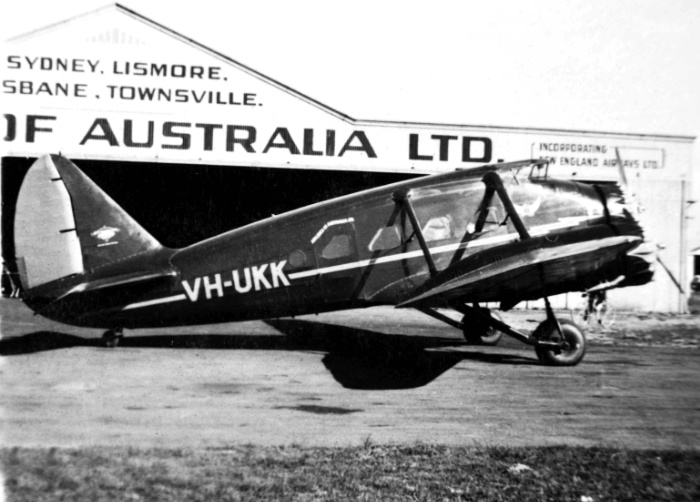
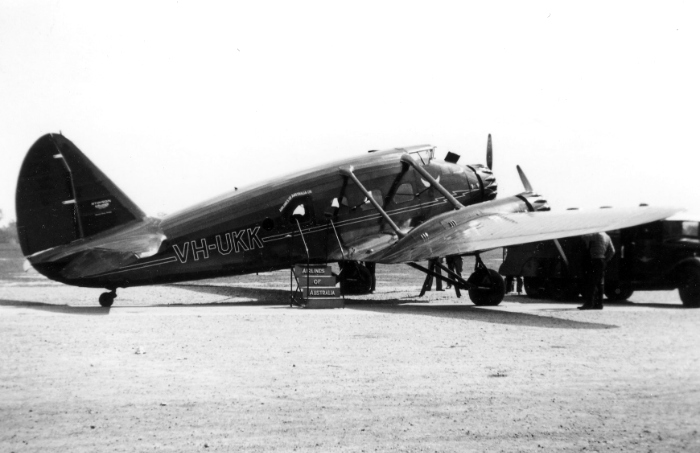
Refuelling
at
Mascot.
Frank Walters collection
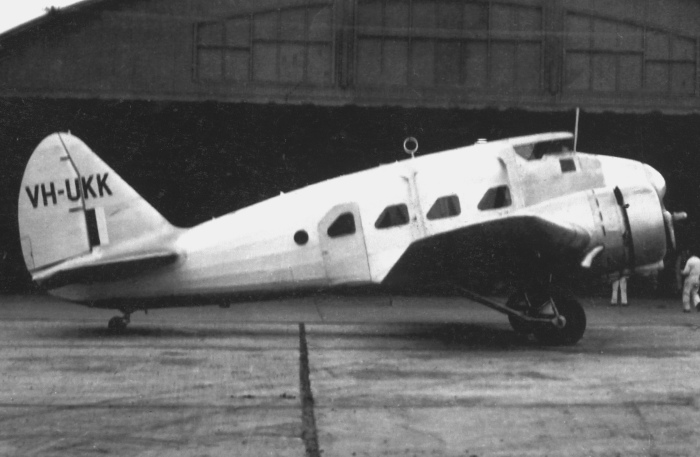
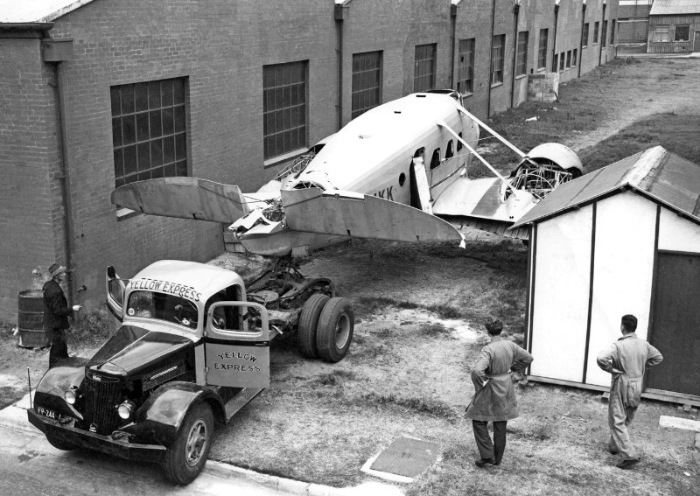
Photo: John Hopton Collection
| 17.10.36 |
Built at Wayne, Michigan by Stinson Aircraft Corporation at their plant adjoining Detroit Metropolitan Airport. Three 245hp Lycoming R-680 radials |
| 23.8.36 |
Airlines of Australia announced that it had orderd a fourth new Stinson A |
| 14.12.36 |
Arrived Sydney as freight on board SS Port Alma. Moved to Mascot aerodrome for assembly by Airlines of Australia. |
| 29.12.36 |
Registered VH-UYY Airlines of Australia Ltd, Sydney NSW. Named Grafton |
| 29.12.36 |
Australian CofA issued after test flights at Mascot. Unlike the previous three Stinson As, VH-UYY was delivered with wireless installed. The weight penalty of the radio equipment resulted in this aircraft carrying one less passenger. |
| 1.12.38 |
Tailwheel damaged while landing at Mackay Qld |
| 7.6.39 |
Forced landing at Cairmns Qld, propeller damage |
| 29.2.40 |
Minor damage during emergency landing at night at Bowen Qld |
| 9.5.40 |
Struck airfield boundary fence durimg landing Innisfail Qld |
| 42 |
Chartered
for periods by military authorities for the war effort. Longitudinal
metal side seating was temporarily installed to carry troops. |
| 1.7.42 |
Transferred on merger: Australian National Airways Pty Ltd, Melbourme Vic. Renamed Tokana in ANA's aircraft naming convention for words ending in "...ana" |
| 12.10.42 |
Damaged when ran off runway through airfield boundary fence during landing at Mackay Qld |
| 1.43 |
Due
lack of Lycoming engine spare parts, VH-UKK & VH-UYY were replaced
on the Queensland coastal routes and sent to Essendon Aerodrome,
Melbourne for re-engining. |
| 9.43 |
Completed rebuild by ANA at Essendon with two 550hp P&W R-1340-AN1 Wasp radials |
| 9.43 |
Test flown Essendon. DCA approval to enter airline service. |
| 1.10.43 |
Pilot Log book ANA First Officer Charles D. Pratt: VH-UYY scheduled service Essendon-King Island-Smithton-Launceston return. Captain K.Nicholes (Pratt usually rostered on ANA DC-2s) |
| 2.10.43 |
Formal CofA renewal as Stinson A-2W |
| 12.11.43 |
Log book ANA First Officer Charles D. Pratt: VH-UYY scheduled service Essendon-Kerang -Mildura -Broken Hill return. Captain D.Dunn |
| 19.12.43 |
Log book ANA First Officer Charles D. Pratt: VH-UYY scheduled service Essendon-King Island- Smithton-Launceston return. Captain Condell |
| 44 |
Based Melbourne, mostly used on services to Broken Hill and Tasmania, with VH-UKK |
| 9.3.44 |
Emergency landing at Kerang Vic after being
struck by lightning in flight at 4,500 feet altitude. Explosion in
cockpit blew out the roof escape hatch and cockpit door breaking the
closing pins, shattered a side window and destroyed the trailing HF
aerial. Scheduled ANA service Melbourne-Kerang-Mildura-Broken Hill, Captain Hugh J. Bond, First Officer |
| 31.1.45 |
Broke up in flight, crashed near Spring Plains, Mia Mia near Heathcote Vic Port wing detached in flight and tailplane broke away during the uncontrolled descent, both sections found some distance from the main burnt-out wreckage. Broke up 20 minutes after departure from Essendon on a scheduled ANA service to Broken Hill via stops at Kerang and Mildura. Captain Alan L.Murn, First Officer Orville D.Openshaw and 8 passengers were all killed. |
| Airframe total time 13,763 hours, 2,797 hours since conversion to A-2W |

Archerfield
Aerodrome, Brisbane
1938.
Ben Dannecker collection



VH-UYY
repainted in camouflage at Horne Island, Far North Queensland 1942.
David Vincent
collection
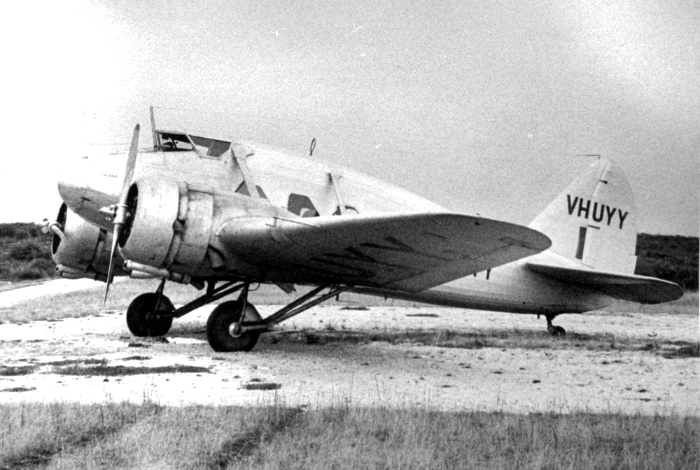
Photo: Charles D. Pratt
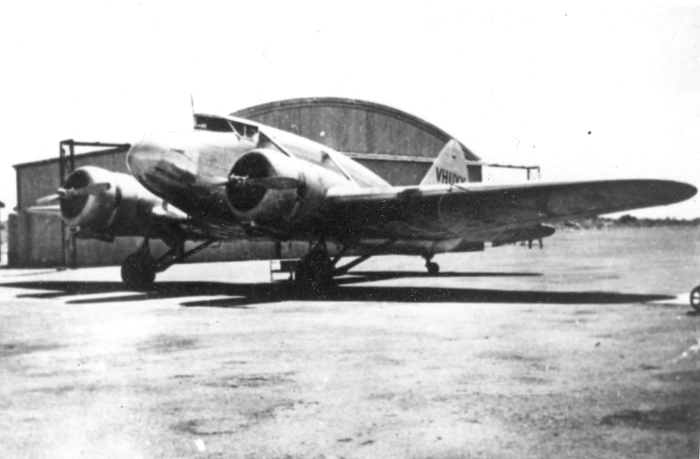
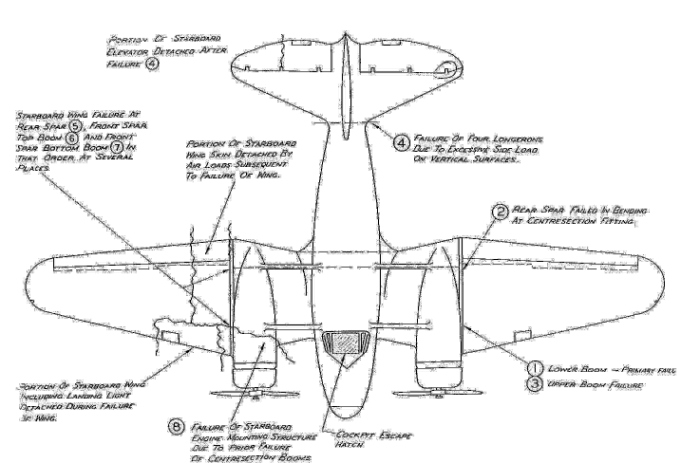
aircraft broke up and fell out of control. Macarthur Job collection, Civil Aviation Historical Society
During 1986 the Australian Kennedy-Miller movie production company commenced work on a TV documentary The Riddle of the Stinson covering VH-UHH's mountain crash in 1937 and Bernard O'Reilly's remarkable feat of locating the wreck and rescuing the survivors. A full size replica Stinson A was constructed and painted in AOA blue and red scheme as VH-UHH Brisbane. The end result was a highly accurate representation of the aircraft.
Scenes of passengers boarding and departure from Archerfield were filmed in May 1987 at Camden Airport, south of Sydney with temporary signage proclaiming it to be "Archerfield Aerodrome".
After filming was completed, the replica Stinson was acquired by Drage Air World at Wangaratta Airport, Victoria and added to their collection of aircraft displayed inside a large purpose-built hangar. Unfortunately this ambitious venue was closed to the public in 2003 following continuing financial losses and the collection sold off by auction.
The long-established O'Reilly family's Guest House in Lamington National Park, renamed O'Reilly's Rainforest Retreat, acquired the Stinson replica and displayed it alongside their guest house. It had deteriorated from weather exposure when in late 2016 work commenced on new fabric and painting to restore it to "as new" condition in time for the 70th Anniversary of the crash in February 2017.
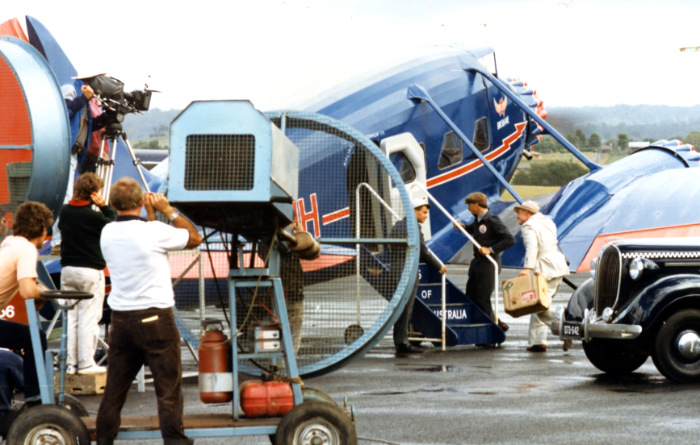

A period picture in the late 1930s which captures the Airlines of Australia Stinson trimotor era:
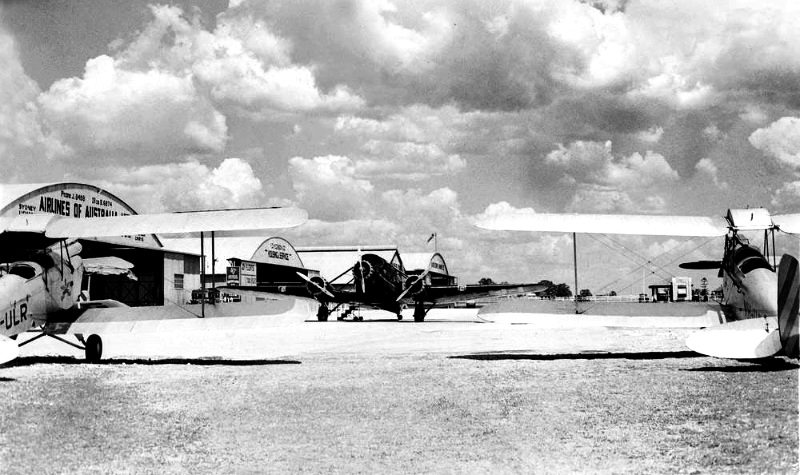
- Australian Civil Aircraft Register, Department of Civil Aviation, Melbourne
- DCA aircraft files, National Archives of Australia, Melbourne
- Trove Australian newspaper search, National Library of Australia
- Flypast - A Record of Aviation in Australia, Neville Parnell & Trevor Boughton, CAA 1988
- Australia's Two Airline Policy, Stanley Brogden, Melbourne University Press 1968
- Virtue In Flying - A Biography of Pioneer Aviator Keith Virtue, Joan Priest, Angus & Robertson Publishers, 1975
- Charles Pratt of Belmont Common, Kevin O'Reilly, self-published 2016
- Air Crash, Volume 1 1921-1939, Macarthur Job, Aerospace Publications, 1991
- Air Crash, Volume 2 1940-1970, Macarthur Job, Aerospace Publications, 1992
- Airlines and Aircraft of the Ansett Group, Fed Niven, September 2019 edition